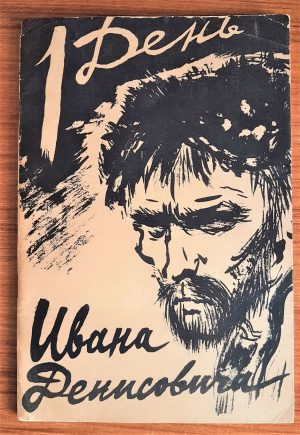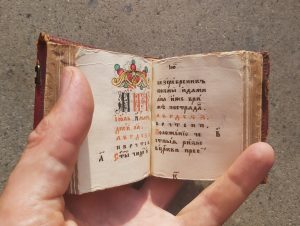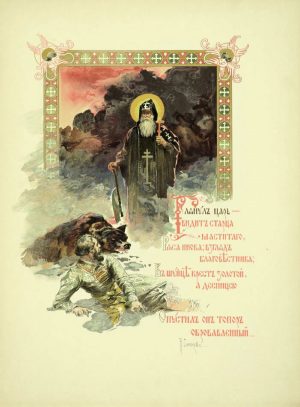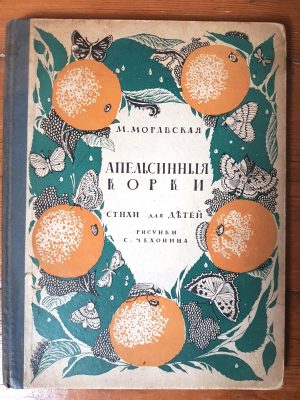Our Notes & References
First edition of the first ABC printed in Moscow, and the first in Russia. One of the earliest attempts to standardise and distinguish Russian grammar from other Eastern Church Slavonic dialects. “A significant step forward not only in the publication of educational books, but also in the development of education [prosveshchenie] in Moscow” (Botvinnik, our translation here and elsewhere).
A complete example, with only a couple of conservative restorations, in its contemporary binding: exceptional.
Of greatest rarity: no copy traced at auction, and Worldcat locates only one physical copy (Royal Danish Library); we could however confirm at least two holdings in Russia (RGB and State Historical Museum; Zernova adds three other locations).
“Burtsov’s figure is comparable to the greatest East Slavonic enlighteners of the late 16th and first half of the 17th century: Ivan Fedorov, Onisym Radishevskyi, Kyrylo Stavrovetsky” (Sazonova). He was the first in Russia to publish books of “secular content for a broad audience [and] the first in the Moscow state to publish primers of the Church Slavonic language” (Agadzhanov). Burtsov even carried a special title of “podiachii azbuchnogo dela” [“manager of alphabet business”] and was the last person of the Moscow Print Yard who had the position of a head of printing work, “apparently managing the publishing process at all stages – from the compilation of a book to its publication”. After Burtsov, the Print Yard and its mills were managed by the Prikaz (Sazonova).
Prior to the publication of this Bukvar, Burtsov’s third and most famous book, students in Russia learned the alphabet and grammar with the Psalter. Burtsov’s primer immediately gained great popularity and served as the main aid for teaching literacy until the end of the 1650s for students “of all classes, from peasants to those from the highest aristocratic families” (Agadzhanov). Some scholars even assume that this first edition was used for the literacy training of the five-year-old future tsar Alexei Mikhailovich (Sazonova).
The Bukvar, like other works by Burtsov, stand out for its innovative features in both content and design. Unlike previous alphabet books, it employs red colour to highlight letters, syllables, and names of its parts and sections. In genera,l it “is characterised by simplicity and clarity of font and graphic design; each page […] has a well-thought-out structure” (Bogdanov). Unlike most Russian printers, Burtsov also credited himself in colophons of his books, a practice more commonly seen in Ukrainian and Belarus printing; he had close ties with masters of these regions and used their examples as models to advance printing culture in Russia.
The first Russian ABCs, Ivan Fedorov’s Lviv (1574) and Ostrog (1578) editions, served as main models. Like them, Burtsov’s Bukvar combines materials for learning the alphabet, grammar and for reading practice; the alphabet is given first in standard and then in backward and mixed orders, followed by two- and three-letter syllables, the numbers and punctuation marks. It also gives information about conjugation and forms of the passive voice, as well as examples of the declension of nouns and adjectives. The second part contains prayers, parables of King Solomon and various moral instructions.
Compared to Fedorov’s ABCs however, the Bukvar introduces more grammatical material and pays greater attention to syntax and punctuation. Burtsov attempted “to unify the spelling of words and grammatical structure of the Russian language in the Moscow state […] In the conjugation of verbs Burtsov tried to find his own variant, closer to the Moscow official language of that time; he put considerably more accents in words”; the spelling of individual words also distinguishes his primer from the ones by Fedorov (Botvinnik). “The changes and clarifications made by Burtsov show that this work is not a simple reprint [perepechatka, of Fedorov’s works], but an improved manual for teaching writing and reading. Burtsov’s Bukvar became the main manual for teaching literacy in Central Russia. This book rightfully occupies an important place in the history of our primers” (Bogdanov; our highlighting).
Some scholars suggest that the present edition, printed on 20 August 1634, followed two earlier editions of Bukvar, each with a print run of 500, that did not survive (Agadzhanov). We could not find any trace of these editions, and the present one is usually considered the first.
In 1637 Burtsov issued the second edition of his primer, this time with a woodcut frontispiece and additional texts; this second edition was repeatedly reprinted in the following centuries, in particular in 1781 in Suprasl and in 1875 in Moscow by Old Believers who considered Burtsov’s primers true examples of an “Old Orthodox” book (Agadzhanov).
When Burtsov finished his printing practice in 1642, he “did not give or sell his inventory to the Print Yard. The fonts, printing boards, and most of the printing decorations were lost forever” (Sazonova). The last mention of him dates back to 1647-1648, when his printing house was finally closed and he had to sell some of the remaining manuscript materials.
This copy is exceptional for its condition: we acquired it with only one minor ancient restoration, but a leaf was quite badly torn, albeit with very little loss of text. We decided to have this leaf restored visibly (“conserved”), to clearly distinguish the new material from the original. Except this, and a minor restoration to another leaf, the book has kept its original condition, worn through the centuries and ‘unsophisticated’, still in its contemporary binding, which allowed to keep ample margins. This is a very rare and much appreciable case for a pre 18th-c. Slavic, Slavonic or Russian book, which are too often heavily restored and ‘sophisticated’, sometimes with leaves or bindings supplied from other copies or even other books. There is no trace of any sort of stamp either, nor clear previous ownership.
Our copy is complete: we compared it page to page to the RGB copy, complete itself, fully scanned and available online. This actually allowed us to note a wrong order of pages towards the end of the scanned copy, which may come either from a scanning mistake or the copy itself.
The wide margins have allowed to keep something very rarely found in early Moscow imprints: the mark of the press itself used by Burtsov. “This is what is called mark of the teredorshchik, ie. printer. Burtsov was printing on specific presses (dedicated to his use). Therefore the letters are read as B(u)r(tsov)” (Shustova). These letters, in Cyrillics B and r, appear on the upper left hand corner one just one page, a very unusual and unexpected sign. According to Shustova, it is very rare and most interesting, as copies of Burtsov’s books are generally cropped, as can be seen on another page on the scan of the RGB copy, which Shustova described in her voluminous catalogue.
Provenance
Private collection, France.
Bibliography
Zernova 103; not in Sopikov (who wrongly mentions two editions in 1637 (Nos. 160-161), the first one possibly being ours).
Agadzhanov B. V. “Sozdateli pervykh uchebnykh knig dlia nachalnogo obucheniia gramote – Bukvarei i Azbuk XVI – pervoi chetverti XVIII vv.” // Problemy sovremennogo obrazovaniia. 2010, #2.
Bogdanov V. P., Karpiuk G. V., red. Markushevich A. I., Ot Azbuki Ivana Fedorova do Sovremennogo Bukvaria, Moskva, Prosveshchenie, 1974, p. 86.
Botvinnik, Marat. Otkuda est poshel bukvar, Vysheishaia shkola, Minsk, 1983, pp. 98-105 (illustrated).
Sazonova L. I., Guseva A. A. “Burtsov Vasilii Fedorov” // Slovar knizhnikov i knizhnosti Drevnei Rusi, vyp. 3 (XVII v.), ch. 3. SPb, Nauka, 1998, pp. 148-153.
Shustova, Iuliia: private communication about this particular copy, with our thanks. Shustova is the co-author of Kirillicheskie Bukvariiz sobraniia….RGB: opisanie izdanii i ekzempliarov, 2018 (The Cyrillics Primers of the….State Library: description of editions and copies).
Physical Description
Small 8vo. [90] ll., complete, printed in red and black, woodcut headpieces, a 3-line woodcut initial, red initials.
Binding
Contemporary dark brown calf over wooden boards, elaborate and different blind decorations to covers, traces of metal clasps.
Condition
Binding worn and totally exempt of restoration, spine missing showing details of sewing, boards rubbed at extremities with small loss of leather, lower board scratched and generally more worn than upper board which remains pleasant, blind decorations clearly visible, clasps missing.
Crisp internally,, with wide margins, some light staining or soiling, mostly marginal, edges sometimes frayed, two leaves recently restored affecting just a few letters, one leaf with ancient restoration with paper obscuring a few letters. One ancient marginal ink inscription.
































